
國府理展 相対温室
2014年4月26日(土)~6月22日(日) *4月30日以降中止
國府 理
KOKUFU Osamu
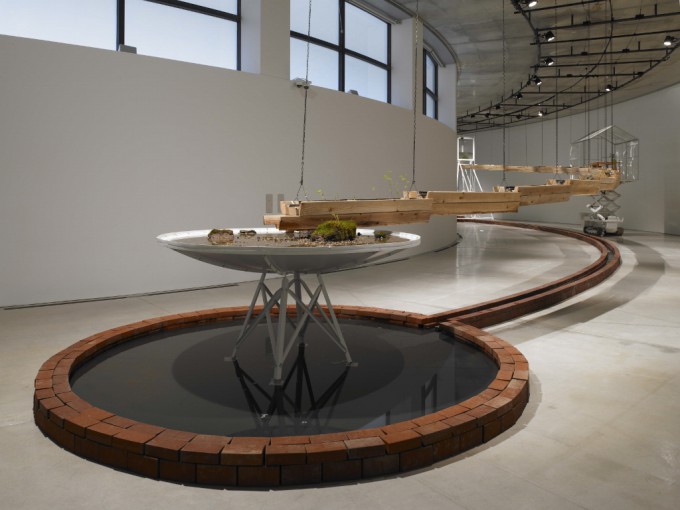
國府理《相対温室》2014年
撮影:山本糾
《相対温室》がみせる世界の縮図
近藤 由紀
國府理は、車を中心とした乗り物やエンジンなどの動力を使い、空想科学的な世界を感じさせる作品や乗り物を一貫して制作し続けている。本展でも展示された《自動車冷蔵庫》(1998年)は、作家が実際に乗っていた自動車のエンジン部分に冷凍装置を取り付けた、いわば自動車型の冷凍庫なのだが、劣化を遅らせ「保存」する冷凍装置と乗り物の組み合わせは、レトロフィユーチャーなタイムマシンを想起させる。
一方で高い技術力で、職人さながらに車や部品を扱いながらも、作品はその手わざを強調するのではない。最終的な発表が車や乗り物の形をとるため「モノ」作りの技術の印象は強いが、乗り物や車は、画家の絵具や筆のように作家の内なるものを外化するための媒介として機能しており、その素材、質感、さらにはその構造が作者の造形言語の体系を支えている。そのことは、國府が同じパーツを組み替えながら作品を制作しつづけるばかりではなく、興味深いことに、他の作家と作品の一部を共有するなどしていることからもうかがえる。つまり自らが制作した個々の作品や機械は、大きな一つの作家の世界観を構築するための部分として入れ替えが可能であるということであろう。今回ACACで制作された《相対温室》も、水槽、鉄塔、パラボラアンテナといった他の作品で使用されたパーツが再利用されている。だがここでは新作、旧作という区別はほとんど意味をなさないだろう。それらは全体で一つの世界観を、一つの「相対温室」を作り上げているのだから。そしてこの《相対温室》は、この空間のために作られ、この空間でしか成立しないまさにサイト・スペシフィックな作品となった。
ギャラリーの奥には水槽を上部に載せた鉄塔が立ち、その水槽の前面からは木製のプランターがカーブしたギャラリー空間に沿うように段々状に連なっている。プランターにはACACの森の土が詰められており、中央に設置されたプラスチックの樋を伝って水が流れ、その樋に開けられた小さな穴からしみ出した水が少しずつ土にしみ込むようになっている。全長約30mのプランターの列の先には、外径約4mのパラボラアンテナが設置され、水槽からの水の流れをその皿に受け止める。受け止められた水は少しずつ下の水路に落ち、ある一定の量になるとポンプが作動して水槽に戻っていく。水はゆっくりと循環しながら土を潤し、無作為に詰められた土から種子を芽吹かせる。こぼれ落ちる水を受け止める皿には苔生した石が配置され、小さな盆景を作り出している。高いところから低いところに流れる水は植物を生育させ、水豊かな風景を生み出し、再び水源へと戻っていく。それは水をめぐる自然の循環を思わせると同時に、水豊かな私たちの国の原風景を思い起こさせる。このインスタレーションの横には会期中作家がプランターの植物の世話をしたり、その中で時を過ごしたりするための移動式の「人間のささやかな生活の温室」が設置されている。人は水の循環からは切り離されているが、それを静かに見守り、手助けすることで大いなる循環に関与している。
この作品ではほとんどサウンド・インスタレーションといえるほど作品における音の印象が強い。段差をおちる水はプランター内に設置された缶に落ちることで、それぞれの場所から異なる音程と異なるリズムの音を常に響かせている。それらは残響が強いACACのギャラリーの中でこだまし、ぶつかり、涼やかで複雑な明るい音色を奏でている。長い作品は移動しながら鑑賞するのだが、鑑賞者が動くことで反響の場が変わり、視覚的にも聴覚的にも少しずつ変化していく。國府の作品は展示される場所に合わせ制作されるのが常ではあるが、今回のこの作品は空間の高さと長さを十分に利用したという意味でサイトスペシフィックなばかりではなく、音の要素を取り込むことにより、ここでしか成立しえない作品として完成した。
展覧会のタイトルであり、作品のタイトルでもある《相対温室》は、世界と人間の関係を相対的に俯瞰しうる装置としての「温室」(=作品)を表している。「温室」は、何かを守り育てるための自然を模した理想的かつ人工的な生育環境であるが、言い換えればそれはその動植物にとっての疑似環境世界である。現実を凝縮しながらも、現実にはあり得ないユートピア/ディストピアが、それゆえに現実に対する客観的な眼差しをもつことで、茫漠と広がる我々のこの現実世界の様々な価値や事柄を相対的に認識させ得るのは、空想社会小説の例を挙げるまでもないだろう。水が循環し、植物を生育させる装置とそれに寄り添う人間の温室のある作品は、水をめぐる生命の幸せな縮図といえるかもしれない。一方ギャラリーBでは、悪しきものが循環するもう一つの「温室」の作品が設置され、ギャラリーAの作品と対をなしている。広い世界で薄められ、意識外に追いやられていたもう一つの循環は、温室として世界が縮小されることにより、毒々しい緑色の雨となって再び降り注ぐ(《Endless Rain》2014年)。それらは共にこの世界のある縮図として、圧倒的な新緑の森の中、地形を考慮しながらも人工的なラインが強調されたギャラリーの建物それ自体を現実世界を凝縮した一つの「温室」のようにみせ、人為と自然の交わりを入れ子状に示していく。池の中央にはひっくり返った車の上に周囲の土が盛られた《虹の高地》が象徴的に設置され、会期中それらの植物は驚くほどの勢いで成長していった。池の水に反射した姿で初めて車としては正位に映じるその作品に人為と自然の闘争をみるか、融合をみるかは鑑賞者にゆだねられたに違いない。
このように國府の作品ではしばしば植物などが取り込まれることで、自然と人間の二項対立を想起させるが、一方で國府によって制作された「機械」は、その構造自体がこの世界の構造と重ねられ、機能やシステムが抽出されて、世界の縮図のような場を作り出す。さらにその造形言語である機械一つ一つに対する作家の愛は深く、また擬人化された機械たちは、私たちの姿でもある。だからこそそれはしばしば厳しい現実を想起させることでディストピア的な物語世界を想起させながらも、融合不可能と思われた事象の夢想的な対話を心奥に植え付け、小さく芽吹かせるのだろう。
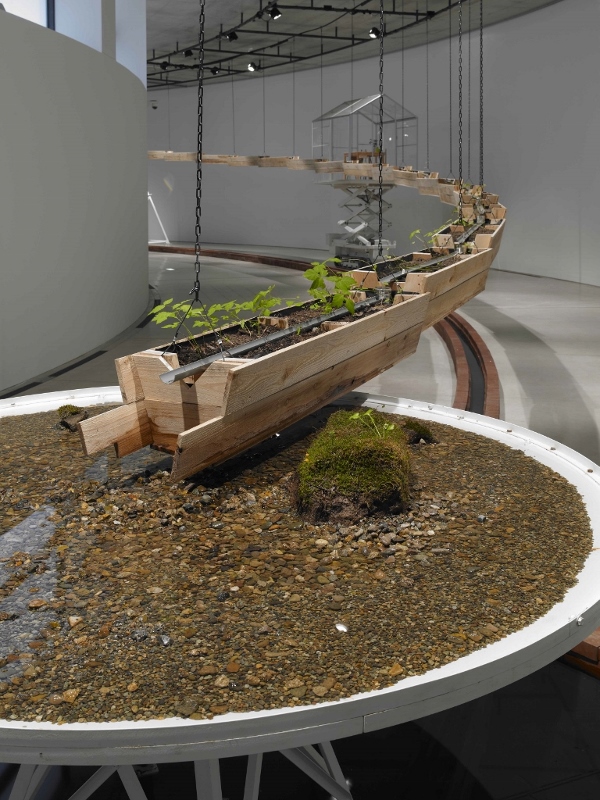
植物が生育した《相対温室》



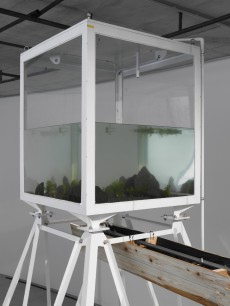
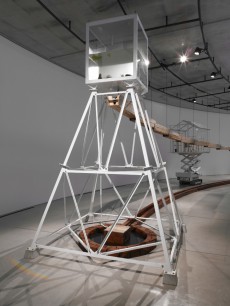
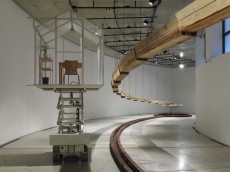

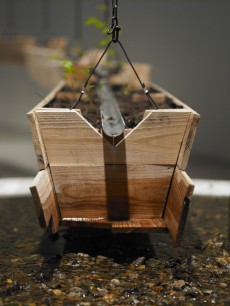

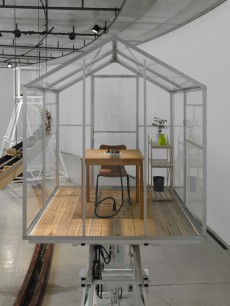

國府理《虹の高地》
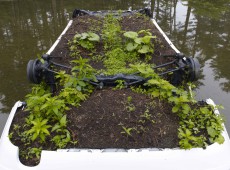
植物が生育した《虹の高地》
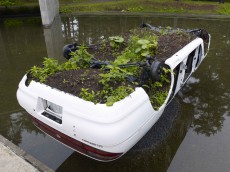
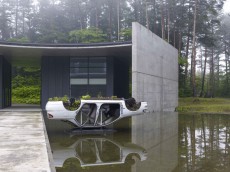
KOKUFU Osamu: Floating Conservatory
April 26~June 22, 2014. *Discontinue the exhibition since April 30.
KOKUFU Osamu
國府 理

KOKUFU Osamu "Floating Conservatory", 2014.
photo: YAMAMOTO Tadasu
A microcosm of the world found in "Floating Conservatory"
KONDO Yuki
Using vehicles, mainly cars, and sometimes the power of engines, KOKUFU Osamu has consistently produced works, which impress us with a taste of science fiction. Car Freezer (1998) displayed again in this exhibition is a so-called car type freezer installed on the engine part of his own car. This combination between a vehicle and freezing equipment, which “preserves” food by delaying rotting, reminds us of a retro-future time machine.
While dealing with cars and automobile parts with refined skills of a craftsman, his works are not to emphasize his skills. As his works are ultimately presented in the form of a car or vehicle, they might give the impression of manufacturing skills, but cars and vehicles function as agents to expose artist’s inner mind like paints and brushes for a painter, and their materials, texture and even structures support the system of his language for artistic creation. This is also relevant in that he produces works by not only rearranging the same parts but also interestingly sharing the parts from other artists’ works. Probably it means that each part and equipment he produces is replaceable as an element within the creation of the artist’s overall worldview. In Floating Conservatory produced at ACAC this time, parts that were used in his old works such as a water tank, steel tower and parabolic antenna were recycled. Here, it seems irrelevant to distinguish between the new and the old because they, as a whole, build up one worldview, one Floating Conservatory. This work has been made special for this space and it is certainly site-specific.
At the back of the gallery stands a steel tower with a water tank on top of it, and wooden planters are arranged in tiers along the curved gallery space from the front of the water tank. Planters are filled with earth brought from the woods of ACAC, and water runs through a plastic pipe fixed in the center. Water soaks out through small holes made in the pipe to sink into earth. At the end of about 30m long row of planters is installed a parabolic antenna of about 4m outer diameter to catch water running from the water tank. Gathered water gradually falls into a lower waterway, and when it reaches a certain amount, the pump begins to work to return the water back to the water tank. The water soaks earth while circulating slowly, and plant shoots come out of soil stuffed in the planters at random. Stones covered with moss are arranged on the dish catching spilled water, unfolding a miniature landscape. Water running from a higher place to a lower plane grows plants, generates a waterscape and returns to the source. This reminds us of natural circulation of water and at the same time, archetypal scenery of our country abundant with water. On the side of this installation is a mobile “little conservatory for a man’s simple life” where the artist could spend time and take care of plants in the planters during the residence project period. Though separated from the water circulation, people are contributing to the great environment by watching it quietly and giving it a hand.
The impression of sound in this work is so striking that it could be called a sound installation. As water running at different levels flows down into cans set in the planters, there are always sounds of different tunes and rhythms from different places. They echo, clash and play cool, complicated and lively sounds in the ACAC gallery where sounds reverberate well. As visitors move along to enjoy this lengthy installation, their movements cause echoes at different places so that there are gradual changes both visual and auditory. Kokufu’s works are usually produced so as to suit the site, and his work this time is not only site-specific in that he made the best use of the height and length of the space but also he introduced the element of sound into the work to make it possible only at this site.
Floating Conservatory, which is the title of both the exhibition and this work, represents a conservatory (= the work) as equipment that makes us recognize the relationship between humans and the world relatively. A conservatory is an ideal and artificial environment to protect and bring up something in imitation of nature. In other words, it is a pseudo-environmental world for animals and plants. There is no need to draw an example of novels on Utopian societies in order to explain that Utopia and Dystopia can make us realize in relative terms various values and affairs in this world expanding vaguely before us. Utopia and Dystopia are actually impossible although realities are condensed in them, and thus they take objective views on realities. This work, which has equipment to grow plants by circulating water as well as a conservatory for a man who stays close to it, could be called a microcosm of happy life around water. In gallery B, on the other hand, another conservatory in which polluted water circulates is installed to make a pair with gallery A. The other circulation, which is thinned down in the vast world and driven away outside our consciousness, pours as green poisonous-looking rain because the world is reduced to a conservatory (titled Endless Rain). Each of the two, a sort of miniature of the world, makes the gallery building appear as another “conservatory” where the real world is condensed. The building is accentuated with artificial lines in the fresh green woods although it is designed to fit geographical features. It is as if relations between human work and nature were indicated in the form of nesting boxes. Highland under the Rainbow, which shows an overturned car with surrounding earth heaped up on it, is set up symbolically in the middle of the pond. During the project period, those plants grew vigorously. The reflection of the overturned car on the pond looks normal, so it must be up to the viewer to see there either conflicts between a man’s act and nature or harmony between the two.
In Kokufu’s works, often with plants, we are reminded of binary oppositions such as nature versus humans. In “machines” produced by Kokufu, on the other hand, the structure itself is overlapped with the structure of the world and its function and system are extracted to create a place like the world’s microcosm. What’s more, the artist has deep affection for each machine as his language for artistic creation, and the personified machines reflect our selves. Although we are reminded of Dystopian discourse when harsh reality is implied, imaginary dialogues between phenomena that never seemed to be fused begin to sprout at the bottom of our hearts.
Translated by NISHIZAWA Miki









KOKUFU Osamu "Highland under the Rainbow"

Plants grown on the "Highland under Rainbow"


